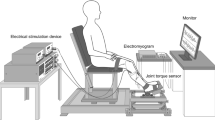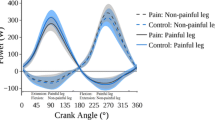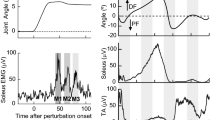Abstract
Purpose
Delayed onset muscle soreness (DOMS) has been shown to induce changes in muscle activity during walking. The aim of this study was to elucidate whether DOMS also affects interlimb communication during walking by investigating its effect on short-latency crossed responses (SLCRs).
Methods
SLCRs were elicited in two recording sessions by electrically stimulating the tibial nerve of the ipsilateral leg, and quantified in the contralateral gastrocnemius muscle. The second recording session occurred 24–36 h after the participants (n = 11) performed eccentric exercises with the ipsilateral calf.
Results
DOMS caused a decreased magnitude of the spinally mediated component of the SLCR in the contralateral gastrocnemius medialis.
Conclusions
The results of the current study provide insight on the relationship between pain and motor control. Muscle pain affects the spinal pathway mediating interlimb communication, which might result in a reduced ability to maintain dynamical stability during walking.






Similar content being viewed by others
Abbreviations
- cGL:
-
Contralateral gastrocnemius lateralis
- cGM:
-
Contralateral gastrocnemius medialis
- DOMS:
-
Delayed onset muscle soreness
- iSOL:
-
Ipsilateral soleus
- iTA:
-
Ipsilateral tibialis anterior
- LLC:
-
Short-latency component
- PPT:
-
Pressure pain thresholds
- RMS:
-
Root mean square
- sEMG:
-
Surface electromyogram
- SLC:
-
Short-latency component
- SLCR:
-
Short-latency crossed response
References
Arendt-Nielsen L, Graven-Nielsen T, Svarrer H, Svensson P (1996) The influence of low back pain on muscle activity and coordination during gait: a clinical and experimental study. Pain 64(2):231–240
Armstrong RB (1984) Mechanisms of exercise-induced delayed onset muscular soreness: a brief review. Med Sci Sports Exerc 16(6):529–534
Berger W, Dietz V, Quintern J (1984) Corrective reaction to stumbling in man: neuronal co-ordination of bilateral leg muscle activity during gait. J Physiol 357:109–125
Chin N, Cope M, Pang M. Number and distribution of spindle capsules in seven hindlimb muscles of the cat. In: Barker D, editor. Symposium on Muscle Receptors. Hong Kong: Hong Kong University Press; 1962. p. 241–8
Cram J, Kasman G, Holtz J (1998) Introduction to Surface Electromyography. Aspen, Gaithersburg
Davey NJ, Romaiguere P, Maskill DW, Ellaway PH (1994) Suppression of voluntary motor activity revealed using transcranial magnetic stimulation of the motor cortex in man. J Physiol 477:223–235
Dietz V, Quintern J, Boos G, Berger W. Obstruction of the swing phase during gait: phase-dependent bilateral leg muscle coordination. Brain Res 384(1):166–169
Duchateau J, Hainaut K (1993) Behaviour of short and long latency reflexes in fatigues human muscles. J Physiol 471:787–799
Duysens J, Tax AAM, van der Doelen B, Trippel M, Dietz V (1991) Selective activation of human soleus or gastrocnemius in reflex responses during walking and running. Exp Brain Res 87:193–204
Duysens J, Van Wezel BMH, Prokop T, Berger W (1996) Medial gastrocnemius is more activated than lateral gastrocnemius in sural nerve induced reflexes during human gait. Brain Res 727(1–2):230–232
Eccles RM, Lundberg A (1957) Spatial facilitation in the direct inhibitory pathway. Nature 179:1305–1306
Ervilha UF, Arendt-Nielsen L, Duarte M, Graven-Nielsen T (2004) Effect of load level and muscle pain intensity on the motor control of elbow-flexion movements. Eur J Appl Physiol 92(1–2):168–175
Falla D, Jull G, Hodges PW (2004a) Feedforward activity of the cervical flexor muscles during voluntary arm movements is delayed in chronic neck pain. Exp Brain Res 157(1):43–48
Falla DL, Jull GA, Hodges PW (2004b) Patients with neck pain demonstrate reduced electromyographic activity of the deep cervical flexor muscles during performance of the craniocervical flexion test. Spine (Phila Pa 1976) 29(19):2108–2114
Frigon A (2017) The neural control of interlimb coordination during mammalian locomotion. J Neurophysiol 117(6):2224–2241
Gervasio S, Farina D, Sinkjaer T, Mrachacz-Kersting N (2013) Crossed reflex reversal during human locomotion. J Neurophysiol 20(9):2335–2344
Gervasio S, Kersting UG, Farina D, Mrachacz-Kersting N (2015) The effect of crossed reflex responses on dynamic stability during locomotion. J Neurophysiol 114(2):1034–1040
Gervasio S, Voigt M, Kersting UG, Farina D, Sinkjær T, Mrachacz-Kersting N (2017) Sensory feedback in interlimb coordination: Contralateral afferent contribution to the short-latency crossed response during human walking. PLoS One 12(1):e0168557
Graven-Nielsen T, Arendt-Nielsen L (2003) Induction and assessment of muscle pain, referred pain, and muscular hyperalgesia. Curr Pain Headache Rep 7(6):443–451
Graven-Nielsen T, Arendt-Nielsen L (2008) Impact of clinical and experimental pain on muscle strength and activity. Curr Rheumatol Rep 10(6):475–481
Hanna-Boutros B, Sangari S, Karasu A, Giboin L-S, Marchand-Pauvert V (2014) Task-related modulation of crossed spinal inhibition between human lower limbs. J Neurophysiol 111:1865–1876
Henriksen M, Alkjaer T, Lund H, Simonsen EB, Graven-Nielsen T, Danneskiold-Samsoe B et al (2007) Experimental quadriceps muscle pain impairs knee joint control during walking. J Appl Physiol 103(1):132–139
Hermens H, Freriks B, Merletti R, Stegeman D, Blok J, Rau G et al (1999) European recommendations for surface electromyography: results of the Seniam Project (SENIAM). Roessingh Research and Development, Enschede
Héroux M, Dakin C, Luu B, Inglis J, Blouin J-S (2014) Absence of lateral gastrocnemius activity and differential motor unit behavior in soleus and medial gastrocnemius during standing balance. J Appl Physiol 116(2):140–148
Hjortskov N, Essendrop M, Skotte J, Fallentin N (2005) The effect of delayed-onset muscle soreness on stretch reflexes in human low back muscles.pdf. Scand J Med Sci Sport 15:409–415
Hodges PW (2011) Pain and motor control: From the laboratory to rehabilitation. J Electromyogr Kinesiol Elsevier Ltd 21(2):220–228
Hodges PW, Tucker K (2011) Moving differently in pain: a new theory to explain the adaptation to pain. Pain 152(3):S90–S98
James EG, Leveille SG, Hausdorff JM, Travison T, Cote S, Conatser P et al (2017) Rhythmic interlimb coordination impairments are associated with mobility limitations among older adults. Exp Aging Res Routledge 43(4):337–345
Jankowska E (2008) Spinal interneuronal networks in the cat: elementary components. Brain Res Rev 57(1):46–55
Jankowska E, Edgley SA, Krutki P, Hammar I (2005) Functional differentiation and organization of feline midlumbar commissural interneurones. J Physiol 565(Pt 2):645–658
Jankowska E, Bannatyne B, Stecina K, Hammar I, Cabaj A, Maxwell DJ (2009) Commissural interneurons with input from group I and II muscle afferents in feline lumbar segments: neurotransmitters, projections and target cells. J Physiol 587(Pt 2):401–418
Jordan K, Challis JH, Newell KM (2007) Walking speed influences on gait cycle variability. Gait Posture 26(1):128–134
Kaufman KR, Hughes C, Morrey BF, Morrey M, An KN (2001a) Gait characteristics of patients with knee osteoarthritis. J Biomech 34(7):907–915
Kaufman T, Burke JR, Davis JM, Durstine JL (2001b) Exercise-induced neuromuscular dysfunction under reflex conditions. Eur J Appl Physiol 84(6):510–520
Kawakami Y, Ichinose Y, Fukunaga T (1998) Architectural and functional features of human triceps surae muscles during contraction architectural and. J Appl Physiol 85:398–404
Lo Vecchio S, Petersen LJ, Finocchietti S, Gazerani P, Arendt-Nielsen L, Graven-Nielsen T (2015) The effect of combined skin and deep tissue inflammatory pain models. Pain Med 16(11):2053–2064
Matsuda Y, Kan S, Uematsu H, Shibata M, Fujino Y (2015) Pain-related brain activity evoked by active and dynamic arm movement: delayed-onset muscle soreness as a promising model for studying movement-related pain in humans. Pain Med 16(8):1528–1539
Mazzocchio R, Scarfò GB, Mariottini A, Muzii VF, Palma L (2001) Recruitment curve of the soleus H-reflex in chronic back pain and lumbosacral radiculopathy. BMC Musculoskelet Disord 2:4
McLean L, Goudy N (2004) Neuromuscular response to sustained low-level muscle activation: within- and between-synergist substitution in the triceps surae muscles. Eur J Appl Physiol 91:204–216
Mrachacz-Kersting N, Gervasio S (2014) Cortical contribution to crossed reflexes in walking humans. In: Jensen W, Andersen OK, Akay M (eds) Replace, repair, restore, relieve—Bridging Clinical and Engineering Solutions in Neurorehabilitation. Springer International Publishing, Cham, pp 575–583
Mrachacz-Kersting N, Geertsen SS, Stevenson AJT, Nielsen JB (2017) Convergence of ipsi- and contralateral muscle afferents on common interneurons mediating reciprocal inhibition of ankle plantarflexors in humans. Exp Brain Res 235(5):1555–1564
Mrachacz-Kersting N, Gervasio S, Marchand-Pauvert V (2018) Evidence for a supraspinal contribution to the human crossed reflex response during human walking. Front Hum Neurosci 12:260
Nichols TR (1994) A biomechanical perspective on spinal mechanisms of coordinated muscular action: an architecture principle. Acta Anat (Basel) 151(1):1–13
Nicol C, Komi P, Horita T, Kyrolainen H (1996) Reduced stretch-reflex sensitivity after exhausting stretch-shortening cycle exercise. Eur J Appl Physiol Occup Physiol 72(5–6):401–409
Pierrot-Deseilligny E, Burke D (2005) The circuitry of the human spinal cord. Cambridge University Press, Cambridge
Prasartwuth O, Taylor JL, Gandevia SC (2005) Maximal force, voluntary activation and muscle soreness after eccentric damage to human elbow flexor muscles. J Physiol 567(1):337–348
Proske U, Morgan DL (2001) Muscle damage from eccentric exercise: mechanism, mechanical signs, adaptations and clinical applications. J Physiol 537(2):333–345
Reisman DS, Wityk R, Silver K, Bastian AJ (2007) Locomotor adaptation on a split-belt treadmill can improve walking symmetry post-stroke. Brain a J Neurol 130(Pt 7):1861–1872
Rossi A, Decchi B, Ginanneschi F (1999) Presynaptic excitability changes of group Ia fibres to muscle nociceptive stimulation in humans. Brain Res 818(1):12–22
Seiterle S, Susko T, Artemiadis PK, Riener R, Krebs HI. Interlimb Coordination in Body-Weight Supported Locomotion: A Pilot Study. 2015;48(11):2837–2843
Slater H, Arendt-Nielsen L, Wright A, Graven-Nielsen T (2003) Experimental deep tissue pain in wrist extensors—a model of lateral epicondylalgia. Eur J Pain 7(3):277–288
Stevenson AJT, Geertsen SS, Andersen JB, Sinkjær T, Nielsen JB, Mrachacz-Kersting N (2013) Interlimb communication to the knee flexors during walking in humans. J Physiol 591(Pt 19):4921–4935
Stubbs PW, Mrachacz-Kersting N (2009) Short-latency crossed inhibitory responses in the human soleus muscle. J Neurophysiol 102(6):3596–3605
Stubbs PW, Nielsen JF, Sinkjær T, Mrachacz-Kersting N (2011) Phase modulation of the short-latency crossed spinal response in the human soleus muscle. J Neurophysiol 105(2):503–511
Tegeder L, Zimmermann J, Meller ST, Geisslinger G (2002) Release of algesic substances in human experimental muscle pain. Inflamm Res 51(8):393–402
Vangsgaard S, Nørgaard LT, Flaskager BK, Søgaard K, Taylor JL, Madeleine P (2013) Eccentric exercise inhibits the H reflex in the middle part of the trapezius muscle. Eur J Appl Physiol 113(1):77–87
Vangsgaard S, Taylor JL, Hansen EA, Madeleine P (2014) Changes in H reflex and neuromechanical properties of the trapezius muscle after 5 weeks of eccentric training: a randomized controlled trial. J Appl Physiol 116(12):1623–1631
Vila-Chã C, Hassanlouei H, Farina D, Falla D (2012) Eccentric exercise and delayed onset muscle soreness of the quadriceps induce adjustments in agonist-antagonist activity, which are dependent on the motor task. Exp Brain Res 216(3):385–395
Author information
Authors and Affiliations
Contributions
SG, SF and NM conceived and designed research. SG and SF conducted experiments. SG and AS analyzed data. SG wrote the manuscript. All authors read and approved the manuscript.
Corresponding author
Ethics declarations
Conflict of interest
The authors declare that they have no conflict of interest.
Additional information
Communicated by Lori Ann Vallis.
Rights and permissions
About this article
Cite this article
Gervasio, S., Finocchietti, S., Stevenson, A.J.T. et al. Delayed muscle onset soreness in the gastrocnemius muscle attenuates the spinal contribution to interlimb communication. Eur J Appl Physiol 118, 2393–2402 (2018). https://doi.org/10.1007/s00421-018-3966-0
Received:
Accepted:
Published:
Issue Date:
DOI: https://doi.org/10.1007/s00421-018-3966-0




